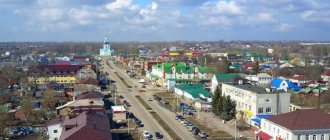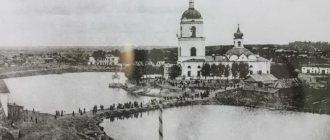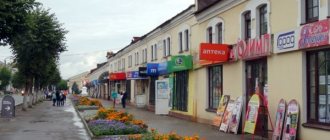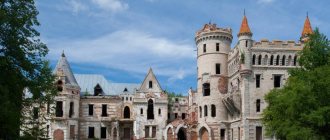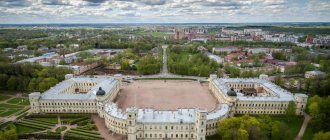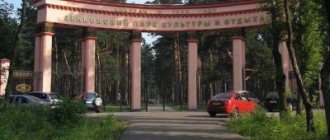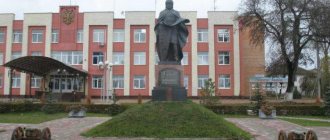In the north-west of the Perm region , where the Kuva and Inva , stands the small city of Kudymkar - the center of the historical, cultural heritage and traditions of the Komi-Permyak people. People don’t come here for entertainment and urbanism, they come here for the authenticity steeped in ethnicity, which can be found in every corner of the city - from low-rise wooden houses with national ornaments to the name of the city itself.
Photo source: Parma-News. Kudymkar
City `s history
The settlement was first mentioned in written sources in 1579, but this is not where the history of the Komi-Permyak land begins. Back in the 7th–17th centuries, on a 40-meter ledge of the left bank of the Kuva River behind a palisade stood the log dwellings of the ancestors of the Komi-Permyaks. They were engaged in hunting, farming, and had trade relations, mainly with the Bulgars. The favorable location served not only as protection from the enemy, but also allowed the ancient tribes to be closer to the Sun and the patron god En .
Photo source: Parma-News. Kudymkar
In the north of the settlement, the indigenous population built a necropolis - modern researchers have discovered burials from the 17th century with Russian crosses, but elements of the funeral rite of the Komi-Permyaks (shallow pits, covered with birch bark). And this is not the only place in Kudymkar where Russian and Komi-Permyak traditions are intricately intertwined. For example, not far from the settlement there is a holy spring , designed in the form of a bear’s head (a symbol that came from Chud antiquities) and regularly consecrated by ministers of the Orthodox Church - this results in a kind of symbiosis of paganism and Christianity. Today, the Kudymkar settlement is a monument of the Rodan archaeological culture and has the status of a monument of federal significance.
Author of the photo: Anton Porsev
There is a legend according to which there once lived a mighty hero Kudym-osh . For a long time he wandered through the dense lands and forests in search of a home, until he came across a ledge on the steep and high bank of the Inva River . Then the hero shouted: “This is where my settlement will be,” and moved to these lands along with his tribe. The city was named after him - Kudym-kar , that is, “the settlement of Kudym.” In general Kudym-osh , being a hero of national legends, is a regular in Komi-Permyak legends and the pride of the Komi-Permyak people.
Neighborhoods of Kudymkar / Photo by: Anton Porsev
But the official chronicle of the settlement is still kept only from the 16th century. At this time, there were only 7 houses and 11 men living here. However, already in 1609 Kudymkar became the center of a district of four villages, and by 1623 it already included 11 villages and 13 districts. In 1700, Kudymkar and other Komi-Permyak villages became subordinate to the Stroganovs . During the ownership of these lands by the princely dynasty, the city grew significantly - if in 1715 about 470 people lived in the settlement, then by 1893 it increased to 1051 people, and there were also 290 households, there was a zemstvo hut, a mill and a stone church of St. Nicholas the Wonderworker , which today is the calling card of the city.
Photo source: Parma-News. Kudymkar
Kudymkar official city status in 1938. Today the city is engaged in processing timber and agricultural raw materials, producing building materials, goods and services for the population.
Industry
In the structure of the city's industry, the leading place is occupied by food. The Kudymkar bakery bakes bread and produces confectionery; OJSC "Meat processing plant "Kudymkarsky" - production of sausages, meat, semi-finished meat products, edible fat. JSC "Moloko" produces milk, sour cream, kefir, butter, cottage cheese, technical casein; JSC "Fishchekombinat" - confectionery products. The woodworking industry is represented by Furniture Factory JSC (production of furniture, lumber, cooperage products).
Attractions
Monument to Kudym-Osh
Kudym-Osh is a national hero and a frequent guest in the legends of the Komi-Permyaks. It is believed that he was the leader of the tribe, whose descendants became the Komi-Permyaks.
Author of the photo: Anton Porsev
He had supernatural strength and courage, rode an elk, and not a single weapon in the world could kill him. And if someone did injure him, then Kudym-Osh could heal by clinging to the ground. According to legends Kudym-Osh cared so much about his tribe that for the sake of their protection he lived 150 years and promised to return from the afterlife to the city Kudymkar .
And he didn’t lie. Since 2008, Kudym-Osh has been watching over the descendants of its tribe from a bronze pedestal in the company of an owl and a bear. At the same time, the whole trinity is depicted leaving the book. The author of the composition was a native of Kudymkar, Valentina Rakisheva . According to the sculptor, she spent her childhood in a house that stands exactly in the place where Kudym-Osh laid the first stone for the foundation of the city.
Where: st. Likhacheva, 54
Park named after I. Ya. Krivoshchekov
Kudymkar City Park is one of the most expensive places for residents. It is not only considered one of the most beautiful places in the city, but also represents high historical and cultural value.
The park has a number of different titles - it is a monument of nature, and of urban planning (not every village of the 19th century could boast of having its own park), and the development of botanical science in the Urals , as well as a unique way to pay tribute to the outstanding person and public figure Ivan Yakovlevich Krivoshchekov .
At the end of the century before last, Krivoschekov ordered seedlings of forest and garden plants from the nursery of the Kazan Agricultural School , which marked the beginning of the creation of a park in Kudymkar . Later, based on observations of these plants, the scientist will write a paper about the experience of their acclimatization in his native village.
In 2007, the park named after I. Ya. Krivoshchekov was beautified - benches and gazebos appeared, and during the reconstruction in 2018, paving slabs were laid, two hundred low-growing plants were planted, a children's and sports ground was installed, and two art objects were opened.
Komi-Permyak Museum of Local Lore named after. P. I. Subbotin-Permyak
The museum was opened in 1921 on the initiative of the avant-garde artist and public figure Pyotr Ivanovich Subbotin-Permyak , whose name was given to the museum in 1945.
Photo source: Komi-Permyak Local History Museum named after. P.I. Subbotina-Permyaka
The main task of the museum is to preserve and broadcast the national and cultural heritage of the Komi-Permyak region. Today it has more than 84 thousand storage units, among which there are unique objects of the Perm animal style, wooden religious sculptures of the late 19th century, Sasanian silver, as well as scientific and cultural objects of local artists, local historians and scientists. For example, the paintings of P. I. Subbotin-Permyak and A. K. Krivoshchekov , the archives of local geographer I. Ya. Krivoshchekov and Hero of the Soviet Union N.I. Kuznetsova .
Over the history of its existence, the museum has managed to make a name for itself by repeatedly participating in the international museum forum “ Intermuseum ”. He also won awards for the projects “ Subbotin-Permyak: there will be a museum!” ", " Museum from the Cradle ", multiple winner of awards from the Perm Territory , Komi-Permyak District in the field of culture and art.
Where: st. March 8, 27
Plotnikovsky burial ground
On the left bank of the Serva River , near the village of Plotnikovo, Kudymkar region , there is an archaeological monument dating from the end of the 12th - beginning of the 15th century - the Plotnikovsky burial ground .
Neighborhoods of Kudymkar / Photo by: Anton Porsev
The graves are located above the water level, and their base is limestone - these factors helped the centuries-old bones and artifacts remain in good condition. In total, about 144 graves were discovered, but most of them were looted - only five children's graves were left without intervention. In 2011 and 2012, the remains of horses were discovered in old graves, the age of which turned out to be much younger than the rest of the remains - radiocarbon dating showed that the horses were buried in the 17th-17th centuries. Archaeologists suggested that the animal was buried in a grave excavated by robbers, so as not to dig a new one.
The Plotnikovsky burial ground is one of the most famous archaeological monuments in the Kudymkar region , telling about the ancient inhabitants of this land.
Where: Kudymkarsky district, near the village of Plotnikovo
Kudymkar settlement
Another archaeological monument of the Komi-Permyak land dates back to the 9th–15th centuries. the city of Kudymkar originates - it was the 40-meter cape where the ancient settlement is located that at one time attracted the attention of the hero Kudym-Osh .
It is assumed that the settlement looked like this
During excavations, archaeologists discovered the remains of above-ground log dwellings, hearths, and holes in the ground from a palisade. Also, in the place of residence of ancient tribes, some tools, weapons, household items, jewelry, and fragments of pottery were preserved.
The Kudymkar settlement is also known under other names - Izyur and Krasnaya Gorka .
Architectural and historical monuments of the city
At one time, many creative and scientific people lived Kudymkar Local residents, who respect the history of their native land, have preserved many of the buildings associated with these prominent people.
Photo source: Parma-News. Kudymkar
Thus, at 23 Kirova Street , P. I. Subbotin-Permyak, lived from 1908 to 1923 . Today it is a historical monument of regional significance, inside which is located the House-Museum of P. I. Subbotin-Permyak . And a couple of blocks from it ( Sverdlova St., 7 ) stands the former house of the founder of Komi-Permyak literature A. N. Zubov .
Closer to the city center you can see a monument of urban planning and architecture - the administrative building " Okrispolkom ", which was founded in 1934. Today it is the only example of constructivist architecture of the 1930s in the area.
V. A. Korkin worked in 1952–1959, was also recognized as a historical monument . It was on his initiative (and with the assistance of the Soviet government, of course) that in 1946 the construction of a two-story brick building of an antitrachomatosis dispensary began. It is located on the street. Yakovkina, 4 .
Education
At the beginning of the 1999/2000 school year, the education system of Kudymkar includes 12 schools with a student population of 5,704. Among them: primary schools - 4, basic schools - 1, secondary schools - 6, gymnasiums - 1. The Komi-Permyak language is studied in one of the schools . The total number of teachers in school institutions is 357. The city’s preschool institutions include 13 kindergartens, of which 3 is a kindergarten school. The system of educational institutions in Kudymkar includes 2 schools (medical and pedagogical), 2 technical schools (agricultural and forestry), 5 vocational schools and lyceums, where they study a wide range of professions and specialties. The Kudymkar State Institute is a branch of Udmurt University, which provides training in the following specialties: management, jurisprudence, history and jurisprudence, technology and entrepreneurship, finance and credit.
MOBU "Gymnasium No. 3"
On September 1, 1989, students crossed the threshold of School No. 3 for the first time. During its existence, the school has gone through an interesting path of development. The first graduation from this school dates back to 1992. In 1994, school No. 3 became a gymnasium school, and a gymnasium vertical was introduced. Since 2001, the school has been providing specialized training. On October 12, 2010, the municipal educational institution “Secondary school No. 3” of the city of Kudymkar was assigned the status of municipal educational institution “Gymnasium No. 3”. This is the only gymnasium in the Komi-Permyak district. “Gymnasium No. 3” is located at Perm Territory. City of Kudymkar, Gagarin Street, 21. Today there are 1,134 students studying at the school. There is a sports ground on the territory of the gymnasium.
A friendly and creative team of 76 teachers works within the walls of the gymnasium. The teaching staff is annually replenished with young talented specialists, among whom are graduates of the gymnasium. The professional level of teachers is quite high: 29% of teachers have the highest category and 50% have the first category. Many teachers are laureates of industry state awards, such as “Honored Teacher of the Russian Federation”, “Excellence in Public Education”, “Honored Worker of General Education of the Russian Federation”, etc. The director of the gymnasium is Nadezhda Viktorovna Kharina - an Honored Teacher of the Russian Federation.
Since 2004, the gymnasium has had a program “Personal Development”, which includes several subprograms: “Creative workshop” (I stage), “Harmony” (grades 5-7), “Ecology of the soul” (grades 8-9), “Know yourself "(III stage). The gymnasium provides conditions for the harmonious development of a moral and free personality. The goal of the educational process is humanization.
Extracurricular activities are well developed in the gymnasium. Every year there is a tourist rally, a KVN game, a “Minute of Glory”, “Drill Song Review”, a “Miss Gymnasium” competition and other events.
Official website of "Gymnasium No. 3"
Sport
The city's children and youth have all the conditions for physical education and sports. There are 4 sports institutions in the city, where more than 600 young and mature athletes train. This is the district SDUSHOR for sambo and judo named after. L.D. Goleva, the municipal youth sports school, the Skier youth sports school with a ski jump complex, and the Parma stadium. Our city has repeatedly hosted the country's best athletes during the All-Union Rural Spartakiad in 1977, the Russian Women's Sambo Wrestling Cup in 1995, the Russian Women's Sambo Wrestling Championship in 1996, and the Russian Youth Sambo Wrestling Championship in 1999 and 2 stages of the Russian Ski Jumping Cup in 2005. All educational institutions and schools in the city have gyms and sections for various sports.

